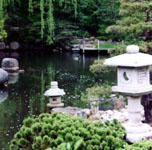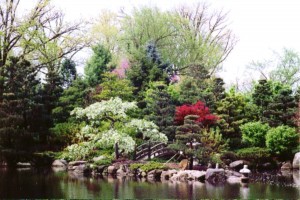The Anderson Japanese Gardens

(Photos by Ellen Park)
The Road Trips Gardener
Japanese gardens are meticulously designed to look natural, because nature never looks that perfect. The Anderson Japanese Gardens, 318 Spring Creek Road, Rockford, Illinois, are no exception. From the fifty-foot-high waterfall cascading down a rocky cliff to koi swimming in a tranquil pond, there are surprises around every turn.
When I visited, I was enchanted everywhere I looked — from the traditional teahouse constructed with no nails to the “deer chaser” fountain fashioned from bamboo. It was early May (one of the best times to visit), and there were blue iris in bud, cherry trees in full bloom, ducks swimming in tranquil ponds, graceful evergreens, stone steps with Chinese calligraphy and rough-hewn wooden benches.
 The waterfall is a key part of a carefully constructed reality designed by a noted Japanese landscape designer but conjured into being by John R. Anderson. A third-generation Rockford resident, Anderson is a senior partner of Spring Creek Partners. This venture capital firm is an outgrowth of a company formed by three Swedish immigrants to Rockford in 1915 to design and build packaging equipment. The offices of Spring Creek Partners overlook the gardens from one side, the Anderson home face the gardens from the other.
The waterfall is a key part of a carefully constructed reality designed by a noted Japanese landscape designer but conjured into being by John R. Anderson. A third-generation Rockford resident, Anderson is a senior partner of Spring Creek Partners. This venture capital firm is an outgrowth of a company formed by three Swedish immigrants to Rockford in 1915 to design and build packaging equipment. The offices of Spring Creek Partners overlook the gardens from one side, the Anderson home face the gardens from the other.
But let’s back up to the beginning. The idea for the gardens took hold in 1966, on Anderson’s first trip to Japan after his graduation from the University of Wisconsin. He was smitten with the arts and culture of the island nation, especially its approach to landscaping. Two years later, when he and Linda married, they bought property in Rockford precisely because it had Japanese garden potential, and built a house on one side of the 10-acre parcel to contemplate their next move at leisure.
Construction on the gardens began in earnest a decade later, when the Andersons hired Hiroshima native, Hoichi Kurisu. A graduate of Tokyo’s Waseda University, Kurisu had studied under Kenzo Ogata, one of Japan’s most renowned landscape designers. Each spring, he spends two weeks at Anderson Japanese Gardens, personally supervising the upkeep of his vision, right down to the weeding and pruning.
Although the majority of the acreage is landscaped in traditional Japanese style, there’s a section, the Garden of Reflection, which is not. Here, Anderson salutes his Scandinavian roots with a trio of soaring bronze angels fashioned by the noted Swedish sculptor Carl Milles.
In 1998, the Andersons formed a non-profit, tax-exempt organization to run the gardens for the benefit of the public, and included a $3 million endowment to ensure its upkeep through the Rockford Rotary Charitable Association. As a result, John Anderson still gets to walk through the gardens on his way to work, and we get to enjoy them as well. What a deal!
 When you visit, pick up a brochure as you enter the gardens for a self-guided tour. The gardens also host a series of educational workshops and other special events open to the public that showcase the gardens, arts and culture of Japan. They’re open daily from May 1 to October 31 (with limited hours in the off-season).
When you visit, pick up a brochure as you enter the gardens for a self-guided tour. The gardens also host a series of educational workshops and other special events open to the public that showcase the gardens, arts and culture of Japan. They’re open daily from May 1 to October 31 (with limited hours in the off-season).
As spectacular as these gardens are, they’re not the only horticultural delight in Rockford. Another must-see spot is the Klehm Arboretum & Botanic Garden, 2701 Clifton Avenue, Rockford, Illinois . Billed as a “living museum,” its exhibits are the plants and trees – it was blooming crabapples when I was there, but planting had begun for the butterfly gardens of summer.
You can tour these gardens on foot (there are two marked trails), or you can arrange in advance for a golf cart tour with a volunteer docent. Bird watchers have this spot marked on their maps because it’s on a migratory path for many species. A botanical reference library lures Midwesterners looking for detailed studies of local plants.
Kids are welcome at Klehm, drawn irresistibly to the boxwood hedge maze in the Nancy Olsen Children’s Garden. When I was there, I had no trouble finding the labyrinth – I just followed the sounds of laughter! Nearby is an interactive sundial (you become the gnomon, the marker casting the shadow that tells the time).
Flowing from southern Wisconsin to the Mississippi River, the Rock River has shaped Rockford since its founding (at the river’s easiest ford, of course). The city has developed a series of parks along its banks. The ten-mile-long paved and lighted Rock River Recreational Path begins at Davis Park downtown, then crisscrosses the river as it winds northward through city gardens and parks. It’s enjoyed by joggers, bicyclers, skaters and walkers alike.
One of the favorite stops along the way is the Sinissippi Gardens, along the Rock River at 1300 North Second Street, Rockford, Illinois. There are swans in the lagoon and tropical plants in the greenhouse as well as outdoor plantings that include a floral clock.
Road Trips Gardeners heading to Rockford should check first with the Rockford Area Convention & Visitors Bureau. Ask for the “Garden Spots” brochure. It lists all the garden locations and special events, and has a listing of farmers’ markets and orchards in the Rockford area.
You can read more about the structure and design of Japanese Gardens here.






